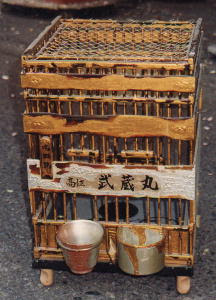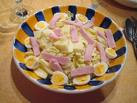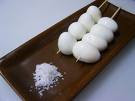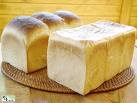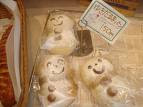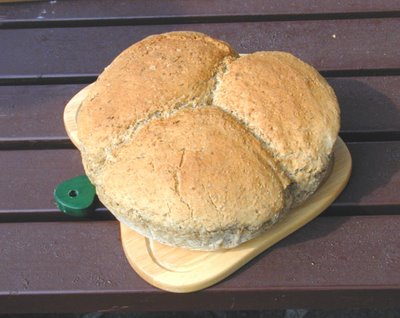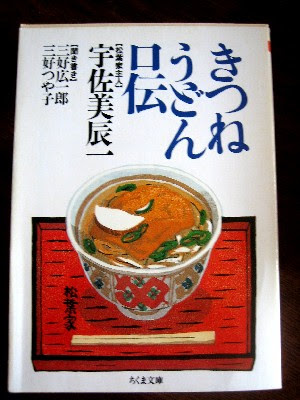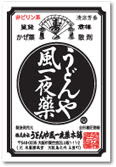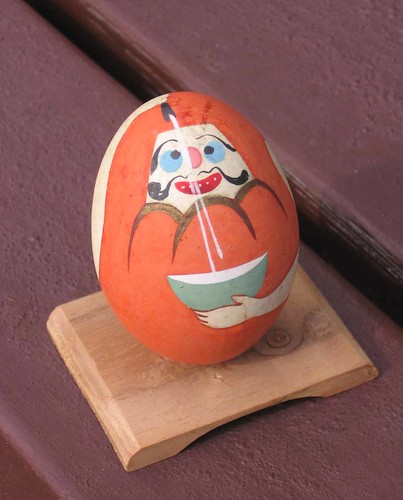[ . BACK to WORLDKIGO TOP . ]
::::::::::::::::::::::::::::::::::::::::::::::::::::::::::::::::::::::::::::::::::::::::::::::::::::
Food from the Bountiful Woods
(Mori no Megumi)
***** Location: Japan
***** Season: Topic
***** Category: Humanity
*****************************
Explanation
The theoretical part with mythology is here :
Food from the Sea, Food from the Mountains
Umi no Sachi, Yama no Sachi ... The Origin
:::::::::::::::::::::::::::::::::::::::::::::::::::::::::::::::::::::::::::::::::::::::::::::::::::::
The Traditional Rural Landscape of Japan
Satoyama 里山 (さとやま)
is a part of the Japanese rural landscape that has been developed from centuries of agricultural use. The concept of
satoyama has several definitions.
The first definition is the management of forests through local agricultural communities. During the Edo era, young and fallen leaves were gathered from community forests to use as fertilizer in wet rice paddy fields. Villagers also used wood for construction, cooking and heating. More recently, satoyama has been defined not only as mixed community forests, but also as entire landscapes that are used for agriculture.
According to this definition, satoyama contains a mosaic of mixed forests, rice paddy fields, dry rice fields, grasslands, streams, ponds, and reservoirs for irrigation. Farmers use the grasslands to feed horses and cattle. Streams, ponds, and reservoirs play an important role in adjusting water levels of paddy fields and farming fish as a food source.
Population decline in villages is considered a significant driving factor in the disappearance of satoyama from Japanese mountains.v
Biodiversity in Satoyama
Various habitat types for wildlife have been provided by mixed satoyama landscape as a result of Japanese traditional agricultural system what also facilitates the movement of wildlife between a variety of habitats. The migration of wild animals can occur among the ponds, rice paddy fields, grasslands, forests, and also from one village to another. Because of these ecosystems, a rich biodiversity in the Japanese rural area has been maintained.
Ponds, reservoirs, and streams in particular play a significant role in the survival of water dependent species such as dragonflies, and fireflies. In early stage of their life cycle, they spend most of their time in water. Through maintaining a mixture of successional stages by the agricultural activities and the management of satoyama, the preservation and promotion of biodiversity are facilitated.
For instance, Japanese oaks and Japanese chestnut oaks are planted by farmers to maintain deciduous broad-leaf trees. Succession to dense and dark laurel forest is prevented by farmers that cut down these trees for fuelwood and charcoal every 15 to 20 years. Most plant and animal species are able to live in these deciduous forests because of traditional management practices. Therefore, much more wildlife can be supported by well managed forests than dark unmanaged laurel forests.
Throughout the 80s and 90s, the satoyama conservation movement was implemented in Japan because people realized that satoyama were needed to maintain healthy ecosystems.
© More in the WIKIPEDIA !
The concept of
satoyama has become widely known through a documentary film with David Attenborough.
Whereas
yamazato 山里 refers to the village in the mountains itself, the reverse,
satoyama 里山, refers to the mountains around a village, especially the part that is used by all for common purposes and in, or rather was, an important part of the rural ecology.
Furusato and Haiku
WKD LIBRARY:
Satoyama -
Japan's creeping natural desaster
By WINNIFRED BIRD, August 2009
and
Hirabari Satoyama Ecosystem, Nagoya, Feb. 2010
平針 (ひらばり) Nagoya 名古屋
 Satoyama Saijiki
Satoyama Saijiki
里山歳時記 田んぼのまわりで
Uda Kiyoko 宇多喜代子
One local reading is
takimon yama 薪モン山 - たきもんやま
a mountain for firewood
It was used commonly by all the farmers living nearby.
.................................................................................
July 2010
. satoumi net 里海ネット Sato-Umi Project
Ministry of the Environment
.................................................................................
October 2010
Convention of Biological Diversity (COP10)
Nagoya Japan
proposes the
International Satoyama Initiative
Anne McDonald
. Reference .
Furusato no Aji 故郷の味、古里の味
"The Taste of my Native Place"
. Furusato : Home village, home town, home land
:::::::::::::::::::::::::::::::::::::::::::::::::::::::::::::::::::::::::::::::::::::::::::::::::::::
In the Kumano area of Wakayama, the god of the woods (mori no kami 森の神) is also the
god of food "tabemono no kami 食べ物の神様".
:::::::::::::::::::::::::::::::::::::::::::::::::::::::::::::::::::::::::::::::::::::::::::::::::::::
Most of the words mentioned below are kigo.
Check the WKD for more details.
:::::::::::::::::::::::::::::::::::::::::::::::::::::::::::::::::::::::::::::::::::::::::::::::::::
Animals from the Forest
Bear (kuma) Bear hunters (matagi)
Iomante Festival and many more.
Matagi ryoori, matagi ryori マタギ料理, the cuisine of the hunters, mostly wild boar, wild hare (no-usagi) and deer.
kuma nabe くまなべ 熊鍋 bear meat hodgepodge
The bear hunters (
matagi マタギ) take a special kind of onigiri into the woods for hunting expeditions. Two rice bowld are filled to the flat with rice and then added together to form one big round ball. Inside just a little bit of dried fish is added. Nothing with vinegar is allowed to be added, since the taste and word SUPPAI (tasting like vinegar) may not be uttered during the hunt ... it could be pronouced like SHIPPAI (to have no sucess) and nobody wants this !
Bärenjäger. Bäreneintopf, Bärenfleisch-Eintopf
Inoshishi, Wild Boar
Botannabe 牡丹鍋 (ぼたんなべ) Wild boar stew
lit. "peony stew".
shishinabe 猪鍋(ししなべ)、inoshishinabe いのしし鍋(いのししなべ)
"whale of the mountain", yamakujira 山鯨(やまくじら)
kigo for winter
Wildschwein-Eintopf
. inoshishi 猪 wild boar 2013 .
Inoshishi Curry and Deer Curry
Kiji, Pheasant
kigo for all spring
Konchu Ryori, konchuu ryoori 昆虫料理
Insects as food
Insekten als Lebensmittel
Shika, deer 鹿
kigo for autumn
Momijinabe 紅葉鍋 (もみじなべ) stew with deer meat
lit. "red leaves stew"
kigo for winter
Hirsch-Eintopf
Meat from horses, usually called
sakura, was also widely eaten.
Horse meat, baniku ばにく/ 馬肉
Sakuranabe 馬鍋 horse meat stew
..........................................
sanniku ryoori, san-niku ryori (山肉料理)
"Mountain Meat Cuisine"
Meat from four-legged animals was not allowed for the pious Buddhist to eat and also not approved in Shinto. But there were exceptions, especially for ill people and for the poor mountain villages and hunter areas, since the Heian period.
kajiki no men 鹿食之免料理
kajiki men, kajikimen 鹿食免
There were even special chopsticks to eat it, kajikibashi 鹿食箸.
The great shrine Suwa Taisha Kamisha (Upper Suwa Shrine) 諏訪神社上社 issued special amulet-permits and the chopsticks to eat "meat from the mountains", which took away the "spiritual pollution" when eating meat.
 箕の中の箸御祓や散霰
箕の中の箸御祓や散霰
mi no naka no hashi o-harai ya chiru arare
in the winnow
there are chopsticks and an amulet -
hail is falling
Kobayashi Issa 小林 一茶
"The thing we should shun more than anything is the meat of wild beasts and birds."
Amateru's Discourse on Healthy Eating
READ MORE ! in the WKD-Library
:::::::::::::::::::::::::::::::::::::::::::::::::::::::::::::::::::::::::::::::::::::::::::::::::::
Berries from the Forest
Yamabudoo 山葡萄 wild grapes
Vitis coignetiae
nobudo, wild grapes 野葡萄 のぶどう
hebibudoo "snake grapes" 蛇葡萄(へびぶどう)
kigo for early autumn
Often prepared with a dressing. The juice is drunk or fermented to wine.
yamabudoo no su-miso ae
. . . CLICK here for Photos !
Scharlach-Rebe
ebizuru 蘡薁 えびづる wild grapes wine
..... ebikazura えびかずら
Vitis thunbergii Sieb. et Zucc.]
:::::::::::::::::::::::::::::::::::::::::::::::::::::::::::::::::::::::::::::::::::::::::::::::::::::
Mushrooms from the Forest
Kinoko, take きのこ(茸/蕈/菌) mushrooms
Read the Details !
Many are kigo for autumn.
:::::::::::::::::::::::::::::::::::::::::::::::::::::::::::::::::::::::::::::::::::::::::::::::::::
Nuts from the Forest
Buna no mi ぶなのみ (欅/椈 の実)beechnut
Beech tree / Fagus sylvatica Ireland, Europe
Buchecker
Chestnut, sweet chestnut (kuri)
Castanea sativa, Esskastanie
kigo for late autumn
... kuri no kanro-ni 栗の甘露煮 chestnuts in syrup
... kachiguri 勝栗(かちぐり) "
winning chestnut"
chestnut to pass an examination. A pun with
kachiguri 搗栗, dried chestnuts.
also spelled kachikuri 勝栗(かちくり).
Some temples and shrines pack them in their talisman packages for examination students.
CLICK here for PHOTOS !
Kurumi くるみ (胡桃) walnuts Walnuss
kigo for late autumn
Nara no mi なら (楢 ) の実 Japanese oak acorns
Quercus dentata
Already eaten in the Jomon period.
Eichel
Tochi とち (橡/栃/杼) horse chestnut
Horse Chestnut (tochi) kigo
Aesculus hippocastanum. Rosskastanie
Tochimochi 橡餅 (とちもち)
ricecakes with horse chestnuts
kigo for late autumn
MORE
. konomi, ko no mi 木の実 (このみ)
"fruit from the tree", berry, nut, seed, acorn ...
kigo for late autumn
:::::::::::::::::::::::::::::::::::::::::::::::::::::::::::::::::::::::::::::::::::::::::::::::::::
:::::::::::::::::::::::::::::::::::::::::::::::::::::::::::::::::::::::::::::::::::::::::::::::::::
Vegetables from the Forest : sansai 山菜
Berggemüse aus Wildpflanzen
essbare wildwachsende Pflanzen
Sansai is often used as ingredients in shoojin ryoori, and the Buddhist vegetarian cooking.

Sansai should be picked fresh from the forest and then eaten soon. But now many varieties are sold in supermarkets and some villages grow them in fields.
Most of them are quite bitter and many are prepared as tempura.
aomono-tori 青物取り taking green things, is still a common word for collecting sansai in spring.
Good places to collect sansai are the deciduous forests of Akita, Niigata, Yamagata and Tooyama.
Sansai Fumi .
Eingelegtes Sansai
Gemüsekombination mit Adlerfarn, Königsfarn, Bambussprossen und Kikurage-Pilzen.
source : www.bosfood.de
Königsfarn. Osmunda regalis : Royal Fern, Flowering Fern レガリスゼンマイ
zenmai ... Taubenfarn. Osmunda japonica
kikurage ... „Quallen der Bäume“. Holunderschwamm. Auricularia auricula
:::::::::::::::::::::::::::::::::::::::::::::::::::::::::::::::::::::::::::::::::::::::::::::::::::::
ABC LIST of sansai
fuki no too ふきのとう coltsfoot, butterbur
Butterbur sprouts (fuki no too) and butterbur (fuki)
On of the earliest forest vegetables and quite bitter.
The outer layer of the stem is peeled off and part of the root cut away. Can be used raw for tempura or in soups. Boiling it shortly and arrange it with dressing or simmer. Also fried with miso (miso itame).
Fuki-Blüte, Pestwurz; Huflattich
kigo for early spring
kyarabuki 伽羅蕗 tsukudani of coltsfoot stems
. . . CLICK here for Photos !
kigo for summer
It takes a few days of repeated simmering to prepare it. It used to be eaten during the war time when no other food was available in the poor communities. The color resembles that of KYARA, a precious fragrant wood.
. . . CLICK here for Photos !
coltsfoot stems, Soja-Bergrhabarber
:::::::::::::::::::::::::::::::::::::::::::::::::::::::::::::::::::::::::::::::::::::::::::::::::::::
gonpachi ごんぱち gonpachi
found in the Kumano forests of Wakayama.
It contains a lot of oxalic acid and "tasts as bitter as life".
Placed in soup or as
oyatsu snack.
Hahakogusa 母子草(ははこぐさ) sweet cudweed
hookogusa 鼠麹草(ほうこぐさ), hahako ははこ, hooko ほうこ
Gnaphalium affine
kigo for late spring
. . . CLICK here for Photos !
Baumwollgras; Ruhrkraut
.................................................................................
 source : maruk-sozai.jugem.jp
itadori 虎杖 (いたどり) Japanese knotweed
source : maruk-sozai.jugem.jp
itadori 虎杖 (いたどり) Japanese knotweed
Polygonum cuspidatum Sieb. et Zucc.
saitazuma さいたずま、miyama itadori みやまいたどり
a kind of
tade smartweed, water pepper
kigo for late spring
The young stems are edible as a spring vegetable, with a flavor similar to mild rhubarb.
The roots of Japanese knotweed are used in traditional Chinese and Japanese herbal medicines as a natural laxative.
© More in the WIKIPEDIA !
Windenknöterich
itadori no hana 明月草の花/紅虎杖
kigo for late summer
. itadori matsuri 虎杖祭(いたどりまつり "knotweed festival" .
at Kifune shrine, Kyoto
虎杖や到来過ぎて餅につく
itadori ya toorai sugite mochi ni tsuki
knotweed -
past its prime
right for pounding mochi
Kobayashi Issa
.................................................................................
Kogomi こごみ, コゴミ kind of fern
Matteuccia struthiopteris
It has a rather pleasant taste and is a favorite sansai. Boil quickly before using it. As
ohitashi or with vinegar or sesame dressing. Used raw for tempura.
Straußfarn
another name for
kusa sotetsu くさ‐そてつ (蘇鉄)
sotetsu is a cycad
. . . CLICK here for kogomi Photos !
ko no me,konome, ki no me
Bud of trees, treebuds (ko no me, konome) with more details
kigo for all spring
koshiabura,koshi-abura こしあぶら / 漉油 . 漉し油/ コシアブラ
"filtered fat"
Acanthopanax sciadophylloides
Grows in many areas of the woods in Japan. Its buds are picked in spring.
. . . CLICK here for Photos !
Tara no me たらの芽 buds of the angelica tree
Eaten as tempura or with dressing. Boil in salt water before using a dressing. Sesame dressing and walnut dressing (kurumi ae). Roast quickly and dip in miso dressing.
. . . CLICK here for Photos !
buds of Japanese mountain pepper, sanshoo
kusagi 臭木 (くさぎ) "bad smelling tree"
Clerodendron trichotomum Thunb
kusagina くさぎな、クサギナ leaves of kusagi.
. . . CLICK here for kusagina Photos !
edible plant in the Kumano area and many other regions. Helps against high blood pressure, nerve pain and headache.
kusaginameshi クサギナ飯 rice with kusagina
. . . CLICK here for kusagi Photos !
:::::::::::::::::::::::::::::::::::::::::::::::::::::::::::::::::::::::::::::::::::::::::::::::::::::
mogirimizu もぎりみず
Also simply called MIZU, water, because it stem contains so much liquid.
Used for soup. Speciality of Tohoku.
イラクサ科ウワバミ属.Of the nettle family.
. . . CLICK here for Photos !
:::::::::::::::::::::::::::::::::::::::::::::::::::::::::::::::::::::::::::::::::::::::::::::::::::::
Nanakusa
Seven Herbs of Spring (haru no nanakusa)
. Japanese parsley or dropwort (seri せり), .
Shepherd's purse, (nazuna 薺),
cottonweed (gogyo 御行, 五形、御形),
Japanese parsley or dropwort (hakobera はこべら / chickweed),
Buddha's Seat(hotoke no za 仏の座) Lapsana apogonoides,
Japanese Turnip (suzuna すずな),
Long Radish (daikon))suzushiro すずしろ.
Seven Herbs of Autumn (aki no nanakusa)
Bush clover (hagi)
Pampas grass (susuki)
... Kudzu flower, arrowroot flower, kuzu no hana くずのはな 葛の花
Pueraria lobata
Large pink (nadeshiko) Wild Carnation
.... yellow flowered valerian, ominaeshi おみなえし 女郎花
Patrinia scabiosaefolia
.... Boneset, fujibakama ふじばかま 藤袴
Eupatorium fortunei
.... baloon flower, Chinese bellflower, kikyoo ききょお 桔梗
Platycodon grandiflorus
:::::::::::::::::::::::::::::::::::::::::::::::::::::::::::::::::::::::::::::::::::::::::::::::::::::
Nobiru のびる (野蒜) wild rocambole
Allium grayi. kind of wild garlic.
also
Allium macrostemon
yamabiru, mountain garlic 山蒜(やまびる)
nebiru, root garlic 根蒜(ねびる)
zawabiru, garlic in a swamp沢蒜(さわびる)
kobiru, small wild garlic 小蒜(こびる)
nobiru tsumu, picking wild garlic 野蒜摘む(のびるつむ)
kigo for late spring
Boil quickly before use. As
ohitashi or with vinegar dressing. The rood part looks like a shallot and has a special taste.
. . . CLICK here for Photos !
Lauchart, wilder Knoblauch
Ooba giboshi, oobagiboshi おおばぎぼうし (大葉擬宝珠) Hosta
Hosta Sieboldiana
..... urui うるい、yuki urui 雪うるい
The long green stem and the white branches are eaten. Has a slightly bitter taste. Boil quickly in salt water. As
ohitashi or with dressing.
. . . CLICK here for Photos !
oyamabokuchi オヤマボクチ ( 雄山火口)
Synurus pungens, a kind of smelly mountain thistle.
made into mochi, also nogonboo mochi のごんぼうもち
Sansho, Sanshoo, Japanese pepper, "Mountain pepper"
:::::::::::::::::::::::::::::::::::::::::::::::::::::::::::::::::::::::::::::::::::::::::::::::::::::
Tonburi とんぶり "mountain caviar"
Tsukushi 土筆(つくし)horsetail plant
..... tsukuzukushi つくづくし, tsukushiba つくしんぼ
fude no hana, "brush flower" 筆の花(ふでのはな)
tsukushi no, field with horsetail 土筆野(つくしの)
tsukushi ae, horsetail with dressing 土筆和(つくしあえ)
picking horsetail plants, tsukushi tsumi 土筆摘(つくしつみ)
kigo for mid-spring
It grows well along the roadside. Our local farmers pick it up on the way home and eat it in the dinner soup or with a dressing. Soak for a long time in water before use. With sesame dressing. With scrambled eggs.
. . . CLICK here for Photos !
Schachtelhalm
. Mafukuda ga hakama yosou ka tsukuzukushi .
Matsuo Basho
deru kui no gotoku tsukushi no tsumarekeri
Kubota Noriko
:::::::::::::::::::::::::::::::::::::::::::::::::::::::::::::::::::::::::::::::::::::::::::::::::::::
Udo, Spikenard, Japanese spikenard 独活(うど)
Yama udo 山独活 Mountain spikenard. Aralia cordata
The name comes from the saying:
even without wind, it is swinging all by itself.
風なくして
独りで
活く
Very crunchy to the taste (shakishaki, knusprig).
It helps when you feel a cold coming in winter.
Peel the outer layer of the stem, cut in oblong pieces, soak in vinegar-water and dry. Eat with vinegared dressings or vinegar miso. The very top of the plant can be used for tempura.
The peel can also be cut finely, put in vinegar-water over night and then used for kinpira or tsukudani.
There is also a proverb
udo no taiboku 独活の大木 useless person
(like a great tree of udo, which is too soft to support his own weight and breaks easily)
Udo ae 独活和 (うどあえ) spikenard in dressing
kigo for late spring
udo no sumiso ae うどのすみそあえ / うどの酢味噌あえ
with misopaste and vinegar dressing
:::::::::::::::::::::::::::::::::::::::::::::::::::::::::::::::::::::::::::::::::::::::::::::::::::::
Warabi わらび(蕨) bracken, fern
Pteridium aquilinum var. latiusclum
picking bracken, warabi tori 蕨採り(わらびとり).
.... warabi tsumi 蕨摘(わらびつみ)
..... warabigari 蕨狩 (わらびがり) "hunting for bracken"
noshi のし (in some dialects)
warabite "hand of fern" 蕨手(わらびて)
kagi warabi "key fern" 鍵蕨(かぎわらび)
ni warabi, boiled bracken 煮蕨(にわらび)
warabijiru, bracken soup 蕨汁(わらびじる)
warabimeshi, rice with bracken 蕨飯(わらびめし)
hoshi warabi, dried bracken 干蕨(ほしわらび)
hatsu warabi, first bracken 初蕨(はつわらび)
sawarabi, early bracken 早蕨(さわらび)
oiwarabi, old bracken 老蕨(おいわらび)
warabitaku 蕨長く(わらびたく)
kigo for late spring
Warabi mochi 蕨餅 (わらびもち) bracken rice cakes
It has a strong acrid alcaline taste and needs special treatment before eating (aku あく(灰汁 ) o toru). It is a well-liked side-dish, as it grows free in the mountain forests and is thus one of the joys of mountain life.
Eaten as tempura or in noodle soups, as topping for soba noodles and other dishes.
Warabimochi from Bashodo, Osaka
Warabi is also collected in autumn to eat its leaves.
Farnkraut, Adlerfarn
"bracken windows" (warabi katou, warabi katoo 蕨火灯) style of temple windows
Haiku by Kobayashi Issa
鳥べのヽ地蔵井の蕨哉
Toribeno no Jizo i no warabi kana
at Toribe cemetery
the bracken near
the Jizo Well
Toribe cemetery and Haiku
. fern, shida しだ、歯朶 .
to decorate the ferns, shida kazaru 歯朶飾る
for the New Year celebrations
.................................................................................
kigo for early summer
natsuwarabi, natsu warabi 夏蕨 (なつわらび)
summer warabi bracken
 一汁に夏蕨ある山暮し
一汁に夏蕨ある山暮し
ichijiru ni natsu warabi aru yamagurashi
in the soup
there is summer bracken -
my mountain life
Kuriko 繰子
source : hammock garden life
.................................................................................
kigo for late winter
fuyu warabi 冬蕨 (ふゆわらび) bracken in winter
fuyu no hana warabi 冬の花蕨(ふゆのはなわらび)
hana warabi 花蕨(はなわらび)bracken flowers
kan warabi 寒蕨(かんわらび)bracken in the cold
hikage warabi 日陰蕨(ひかげわらび)bracken in the shadow
toko warabi 常蕨(とこわらび)
. . . CLICK here for Photos !
:::::::::::::::::::::::::::::::::::::::::::::::::::::::::::::::::::::::::::::::::::::::::::::::::::::
Yomogi よもぎ (艾蓬, 蓬 ヨモギ) mugwort
mochigusa 餅草(もちぐさ)plant for making mochi cakes
mogusa 艾草(もぐさ), yakigusa やき草(やきくさ)
sashimogusa さしも草(さしもぐさ)
yamogi u 蓬生(よもぎう)
yomogi tsumu 蓬摘む(よもぎつむ)picking mugwort
Artemisia princeps - Beifuß
WASHOKU : Yomogi dishes よもぎ料理 yomogi ryoori
kaisan no aida ni furusato ya yomogi-mochi
between sea and mountains
there is my homeland !
rural ricecakes
Matsumoto Yachiyo
yomogi-mochi are special rice cakes made from mugwort and provoke a feeling of homeland and mother's cooking.
Furusato and Haiku
. . . CLICK here for yomogi ricecake Photos !
:::::::::::::::::::::::::::::::::::::::::::::::::::::::::::::::::::::::::::::::::::::::::::::::::::::
Zenmai 薇(ぜんまい) Japanese Royal Fern
or Japanese flowering fern
Osmunda japonica
zenmai tori, picking zenmai ぜんまい採り(ぜんまいとり)
zenmai meshi, rice with zenmai fern ぜんまい飯(ぜんまいめし)
hoshi zenmai, dried zenmai fern 干薇(ほしぜんまい)
kigo for late spring
Together with warebi one of the most loved ferns in spring. Its head when it comes out is curled "like the Japanese hiragana letter NO の” and covered in soft white hair. This resembles an old coin (zeni), hence the naming. When it unfurls, it can grow as much as 60 cm to 1 meter high.
Has a strong acrid taste and needs soaking in water for a few hours before use. Used in fried dishes or nibitashi, simmered or with dressing. Also as tsukemono pickles.
. . . CLICK here for Photos !
Taubenfarn
 ぜんまいののの字ばかりの寂光土
ぜんまいののの字ばかりの寂光土
zenmai no no no ji bakari no jakkoodo
the zenmai fern
is all round and round (like the character の ) -
Jakuko Paradise
Kawabata Hoosha 川端茅舎
Jakko Jodo 寂光浄土 (jakkoo joodo, 常寂光土) "Pure Land of Tranquil Light" is the highest Buddhist Paradise of the four paradises of the Tendai sect.
It is beyond the realm of extasy and the six realms of existence.
The roundness of the new fern is compared to the promised paradise.
Jakukoo-In 寂光院
A nunnery in Kyoto, Inuyama.
:::::::::::::::::::::::::::::::::::::::::::::::::::::::::::::::::::::::::::::::::::::::::::::::::::::
WASHOKU
SPRING VEGETABLES SAIJIKI
:::::::::::::::::::::::::::::::::::::::::::::::::::::::::::::::::::::::::::::::::::::::::::::::::::::
Yama no Sachi Ookoku 山の幸王国
"Kingdom of Mountain Bounty"
Iwate, Yuda Town 湯田地区堆肥, launched in 2003 to sell local mountain vegetables and help the rural area to revitalize.
With the combination of another municipality, the project died in 2005, due to lack of funds.
*****************************
Worldwide use
North America
Buckeye
. . . CLICK here for Photos !
There is a Native American custom among some tribes of carrying buckeyes for good luck, my wife carries hers just to remind her of her childhood home.
home at hand--
in her coat pocket
a buckeye
Larry Bole, 2007
*****************************
Things found on the way
*****************************
HAIKU
牡丹鍋 豊かな森の恵みかな
botan nabe yutaka na mori no megumi kana
wild boar stew -
the fertile woods bestowing
delicious benefits
Gabi Greve
Wild Boar, a KIGO
:::::::::::::::::::::::::::::::::::::::::::::::::::::::::::::::::::::::::::::::::::::::::::::::::::::
Doing laundry -
in grandpa's pants pocket,
a dried acorn.
Zhanna Rader, 2007
:::::::::::::::::::::::::::::::::::::::::::::::::::::::::::::::::::::::::::::::::::::::::::::::::::::
夏の寺豊かな森の風を受け
natsu no tera yutaka na mori no kaze o uke
temple in summer ...
feeling the wind of this
bountiful forest
Iwai Keiko 祝恵子
*****************************
Related words
*****
WASHOKU : General Information
[ . BACK to WORLDKIGO TOP . ]
::::::::::::::::::::::::::::::::::::::::::::::::::::::::::::::::::::::::::::::::::::::::::::::::::::

